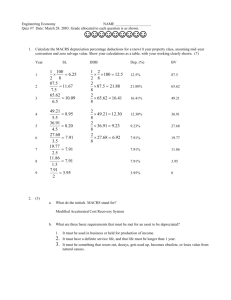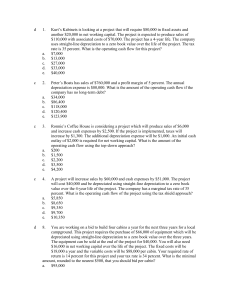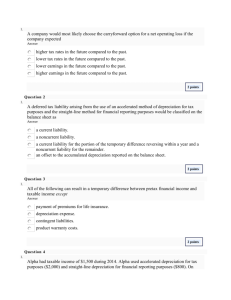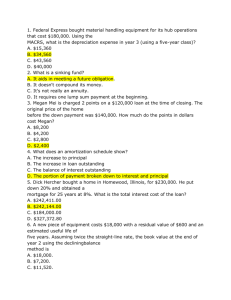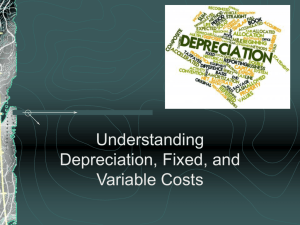Chapter_13_notes
advertisement
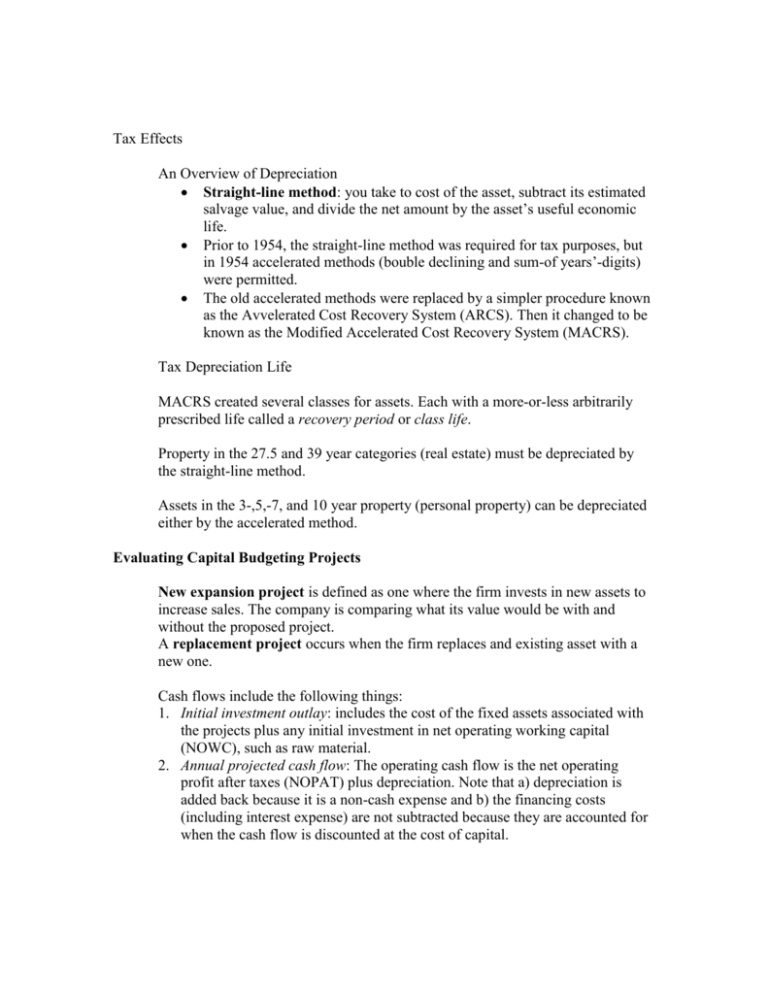
Tax Effects An Overview of Depreciation Straight-line method: you take to cost of the asset, subtract its estimated salvage value, and divide the net amount by the asset’s useful economic life. Prior to 1954, the straight-line method was required for tax purposes, but in 1954 accelerated methods (bouble declining and sum-of years’-digits) were permitted. The old accelerated methods were replaced by a simpler procedure known as the Avvelerated Cost Recovery System (ARCS). Then it changed to be known as the Modified Accelerated Cost Recovery System (MACRS). Tax Depreciation Life MACRS created several classes for assets. Each with a more-or-less arbitrarily prescribed life called a recovery period or class life. Property in the 27.5 and 39 year categories (real estate) must be depreciated by the straight-line method. Assets in the 3-,5,-7, and 10 year property (personal property) can be depreciated either by the accelerated method. Evaluating Capital Budgeting Projects New expansion project is defined as one where the firm invests in new assets to increase sales. The company is comparing what its value would be with and without the proposed project. A replacement project occurs when the firm replaces and existing asset with a new one. Cash flows include the following things: 1. Initial investment outlay: includes the cost of the fixed assets associated with the projects plus any initial investment in net operating working capital (NOWC), such as raw material. 2. Annual projected cash flow: The operating cash flow is the net operating profit after taxes (NOPAT) plus depreciation. Note that a) depreciation is added back because it is a non-cash expense and b) the financing costs (including interest expense) are not subtracted because they are accounted for when the cash flow is discounted at the cost of capital. 3. Terminal year cash flow: At the end of the project’s life, some extra cash flow is usually generated from the salvage value of the fixed assets, adjusted for taxes if the assets are not sold at their book value. Analysis of New Expansion Project See excel example from Chapter 13 – tab table 13-4 Techniques for Measuring Stand-Along Risk There are three types of risk: 1. Stand-alone risk 2. corporate risk 3. market risk Stand-alone risk is important for projects for two reasons: 1. It is easting to estimate a project’s stand-alone risk than the corporate risk and market risk. 2. In general all three risks are highly correlating. There are three techniques for assessing a projects stand-alone risk: 1. Sensitive analysis 2. scenario analysis 3. Monde Carlo simulation Sensitivity Analysis1: is a technique that indicates how much NPV will change in response to a given change in an input variable, other things held constant. This process begins with having a base-case. Meaning, inputting the expected values. Scenario Analysis: we need to deal with the probability distributions of the inputs. For this we use the Scenario Analysis. It provides the extensions – it brings in the probabilities of change in the key variables, and it allows us to change more than one variable at a time. The analysis allows you to do a worst case scenario and a best case scenario. Monte Carlo Simulation: ties together the sensitivities and the probability distribution. It utilizes the mathematics of casino gambling. Introduction to Real Options 1 See page 455 and 456. This is the most widely used Capital budgeting decisions have more in common with poker than roulette because 1) change plays a continuing role throughout the life of the project but 2) managers can respong to changing market condition and to competitors. Managerial options: these are opportunities to respond to changing circumstances, giving managers a change to influence the outcome of the project, also called strategic options. Real Options: they are also called real option because they deal with real assets rather than financial securities. Different types of projects with Embedded Options Investment Timing Options This gives the firm an option to delay the project until a later time. However, option delay is valuable only when 1) it more than offsets any harm that might come from delaying 2) if you have proprietary technology, patenets, licenses, pr other barriers to entry from competition, 3) when the market demand is uncertain and 4) also valuable during periods of volatile interest rates (it can wait until interest rates are lower). Growth Options It allows a company to increase its capacity if market conditions are better than expected. There are several: 1) it lets a company increase the capacity of an existing product line. 2) The second type of growth option allows a company to expand into new geographic markets. 3) The opportunity to add new products. Abandonment Options This is the option to stop a project. Or sometimes they can temporarily suspend or reduce capacity. Flexibility Options This allows the firm to alter operations depending on the conditions change during the life of the project. Valuing Real Options If the project does have a real option you should consider the following: 1) at least recognize and articulate its existence 2) financial options is more valuable if it has a long time until maturity or if the underlying assets is very risky 3) You might want to model the real option along the lines of a decision tree.
